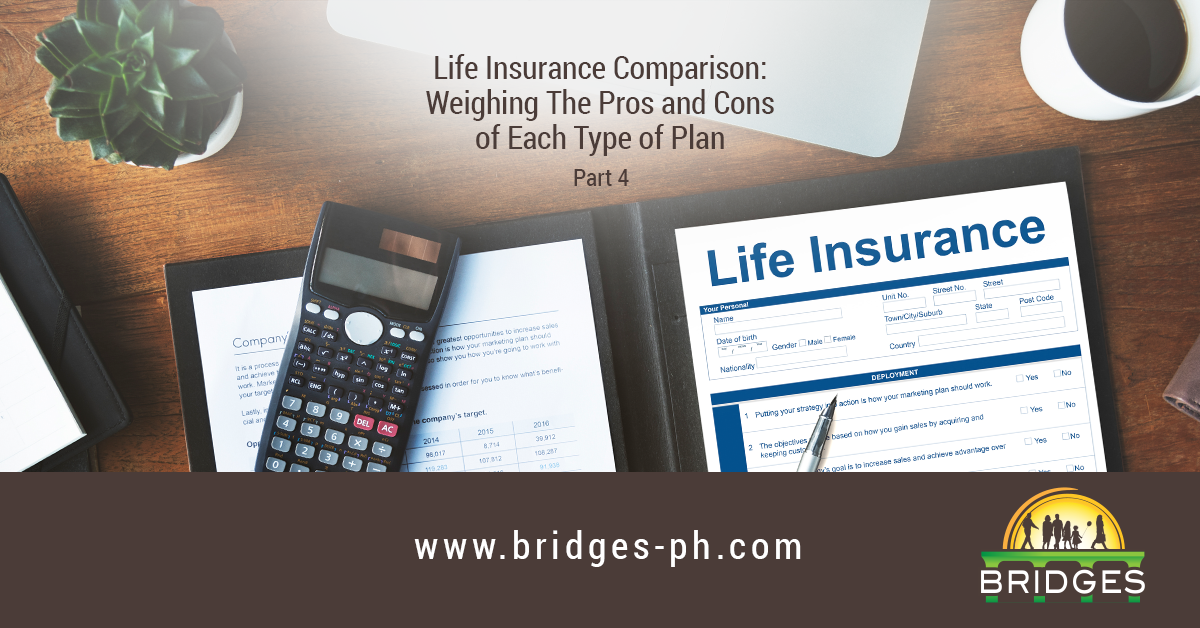
Last week, we took a look at term insurance as part of our ongoing series of highlighting the important benefits and features of the different types of life insurance. We’re doing the same this week for two other types of insurance, namely whole life and endowment plans. Because of some similarities between the two, we decided to group them for this blog entry.
What is whole life insurance
Whole life, as you can probably tell from its name, is a type of life insurance that covers you your whole life. They’re designed to last until you reach 100 years old, which is why they’re usually grouped under permanent life insurance.
This type of insurance also has a savings component on top of the death benefit, unlike term insurance which doesn’t have any living benefits. The premiums you pay for go to two places: the death benefit, which is the insurance coverage itself, and low-risk investments, which is the aforementioned savings component. The investment is guaranteed to grow in time and accumulate what’s called a cash value. This cash value is then paid to your beneficiary together with the death benefit when you pass away.
Alternatively, there are several other things you can do with the cash value in case you don’t want to wait until your death for it to be used. After all, it is considered a living benefit.
First, you can withdraw the cash value for your personal use, be it to supplement your retirement income or pay off an emergency visit to the hospital. Just remember that by doing so, you’re reducing the amount from the savings component that will eventually be paid out to your beneficiary. For example, if you have a cash value of P100,000, and you withdraw P30,000 from it, then only P70,000 will be paid to your beneficiary.
Secondly, you can take out a loan against it. Loans, of course, come with interest, and if you fail to pay your outstanding balance before your death, that amount will be subtracted from your beneficiary’s total payout.
Third, you can use your cash value to pay off the remaining premiums of your plan, which is called the fully paid-up option.
Because you’re enjoying coverage for your entire lifetime, you’ll also be paying premiums your whole life. Premiums, however, are leveled, meaning they start and end at the same amount. The paying period is also guaranteed, so you know exactly how long you’ll be paying premiums for when you sign on the dotted line.
This is where the fully paid-up option comes in. You can use the cash value that’s been built up to pay the succeeding periods of premium to sustain your policy. Sure, your living benefits will become smaller, but choosing this option can provide some financial relief if you ever find yourself struggling to make payments. Plus, you’re essentially securing your coverage until you die.
Endowment, as we mentioned earlier, is not all that different from whole life insurance. While there are standalone plans, an endowment can also be a feature of whole life insurance. They pay a lump sum after a specific term, usually 15 or 20 years. You can avail of this payout upon the maturity of the endowment or leave it untouched for it to grow.
In case you’re not able to pay premiums, you once again have several options.
One is premium advance, which lets your insurer take a loan payment from your cash value. You’ll then have to pay it back with the added interest. Similar to taking out a loan, if you fail to pay it back before you die, the outstanding balance is deducted from the payout.
Another option is paid-up insurance, where you let your insurer use the dividends you earn from the savings component to compute how much coverage they can still offer you. For example, if your current plan covers you for up to P5 million, it’ll then go down to P2 million. The good thing is you no longer have to pay premiums anymore.
The last option we’ll mention here is the paid-up term, which is essentially the same as paid-up insurance. However, instead of the amount of the coverage being lowered, it’s the term. For instance, if your whole life covers you until you’re 100 years old, it’ll be shortened to 75 years old.
With regards to riders, you can avail of total disability and accidental death and dismemberment benefits as well as hospital income and critical illness coverage. Both hospital income and critical illness benefits usually only cover you up to a certain age and not your entire life.
Whole life plans also let you enjoy a paid-up addition option that can come as a rider. This essentially lets you buy additional coverage using the dividends you accumulate. Say you want to add another P500,000 to your plan’s death benefit, you can do so without having to pay increased premiums.
Like term insurance, whole life insurance also has a grace period of 31 days for late premium payments; a reinstatement period of 3 years; and a contestability period of 2 years.
Who is it for
When it comes to whole life insurance, the keyword is “guarantee”. You have a guaranteed paying period; guaranteed future income; and a guaranteed death benefit for your beneficiaries when you die, provided that you don’t give up your plan. On top of that, you can have a fixed endowment that will never go below zero. All these make whole life one of the safest and low risk choices for life insurance coverage.
If you have the money to spare and you’re unsure where to start, whole life insurance is a very good choice to lay the foundations of your financial portfolio. It not only provides you insurance coverage but also investments.
Business owners should similarly consider whole life insurance for their companies due to it being ideal for growth and expansion. They can help in buy-back agreements and serve as a key employee benefit.
Parents who are saving for their children’s college tuition might also want to look into endowments. The same could be said for those who want to preserve their estates.
Confused about what insurance to get? Don’t hesitate to consult professionals. Our office is open to discussing your personal needs and finding the best plan to suit them.
Once again, don’t forget to check back next week for a new entry to this series, where we’ll tackle another type of life insurance.
linkiNG you to opportunities,

photo from www.freepik.com
READ MORE:
- Life Insurance Comparison: Weighing The Pros and Cons of Each Type of Plan – Part 1
- Life Insurance Comparison: Weighing The Pros and Cons of Each Type of Plan – Part 2
- Life Insurance Comparison: Weighing The Pros and Cons of Each Type of Plan – Part 3
- Health Insurance Options: Finding The Perfect Plan For Your Needs – Part 1
- Growing Together: Monetary Incentives To Engage Your Team
- How To Effectively Manage Your Finances During Marriage - Part 1
- Staying Ahead of Life and Death Stakes During the Pandemic – Part 1
- Life Insurance: Preparing for the Inevitable
- How You Can Secure Your Family’s Future From Life’s Uncertainties
- Preparing For Marriage: Priorities, Discipline, and Expectations


